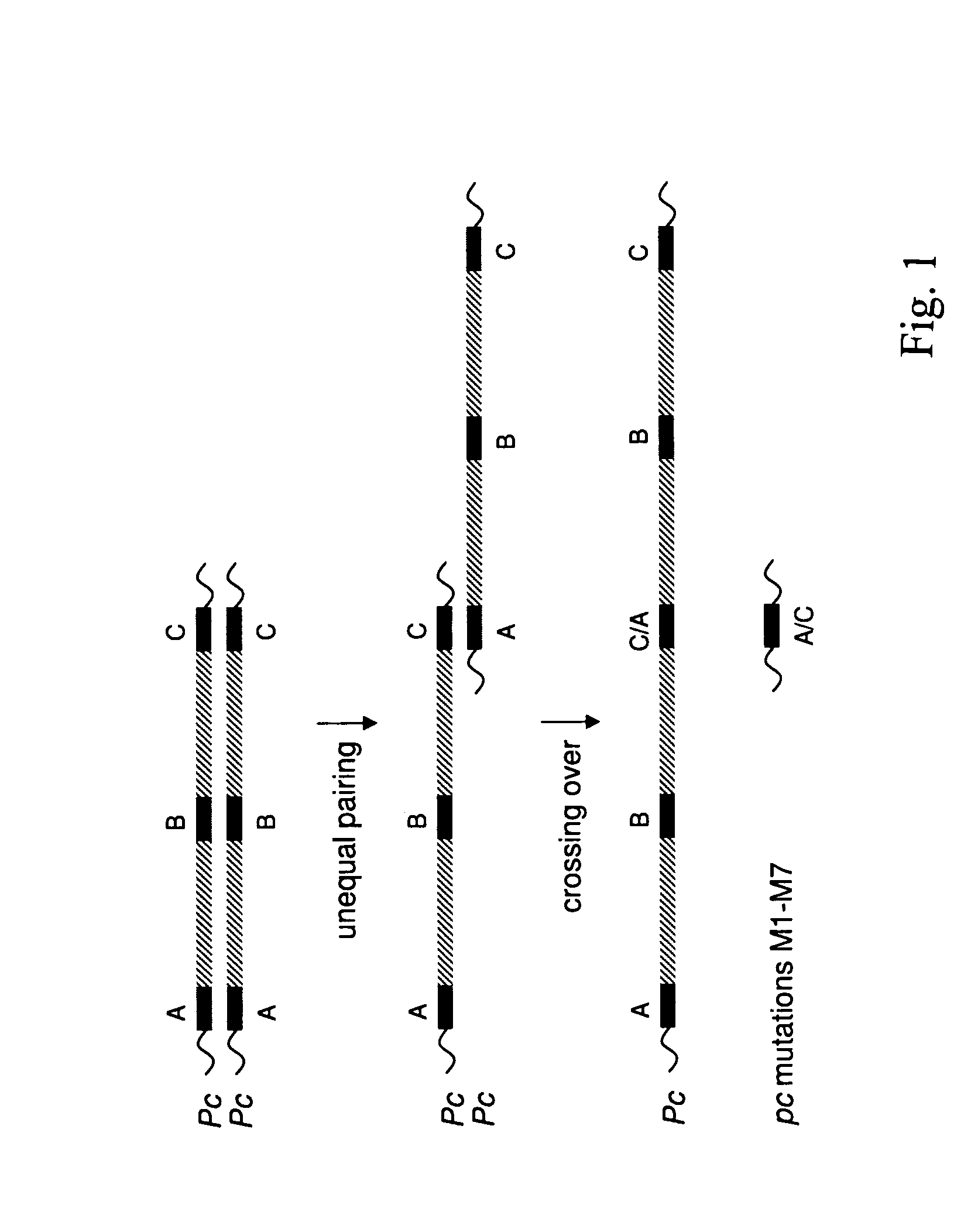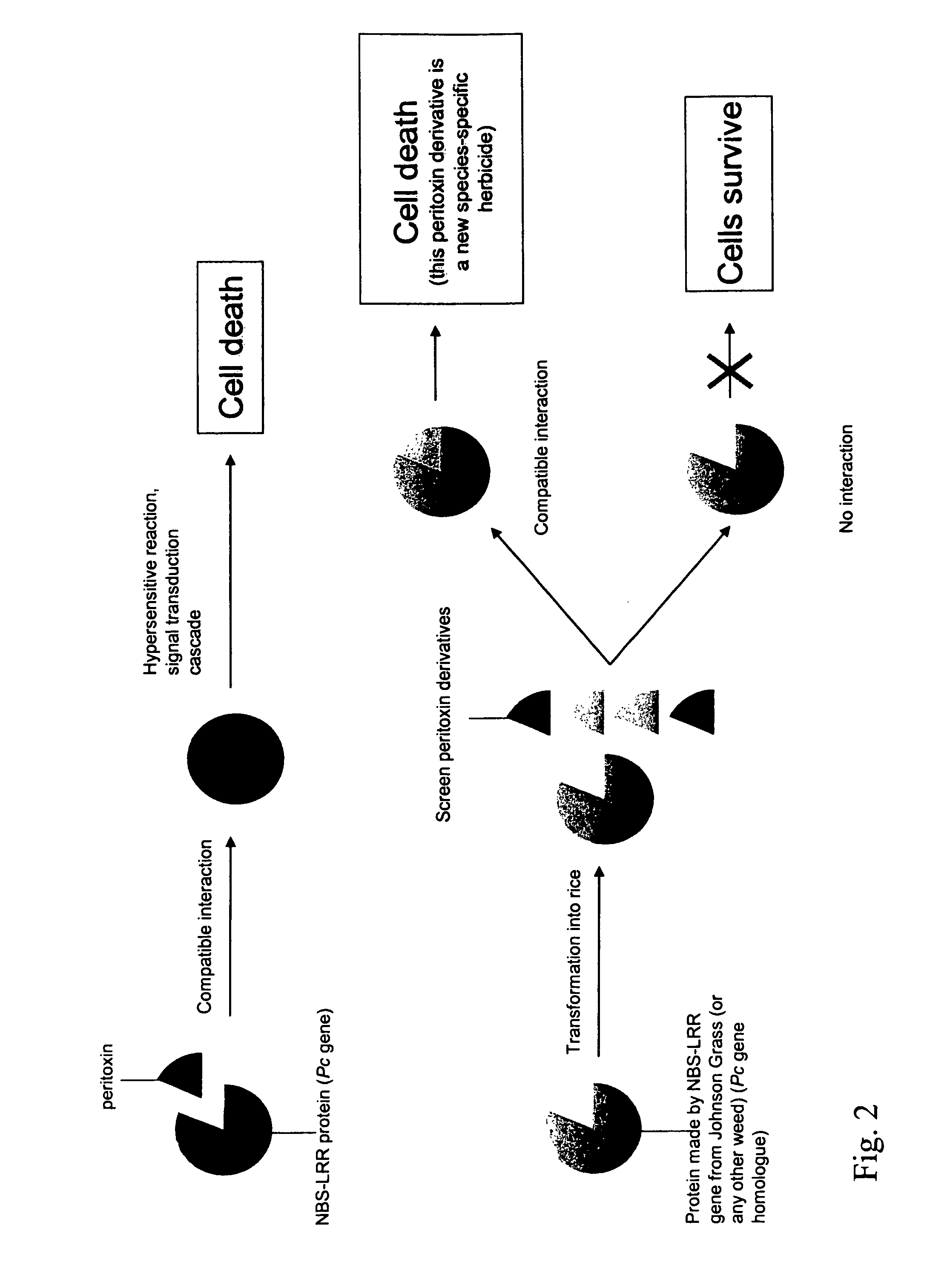Compositions and methods for identifying genetic sequences with toxin resistance in plants
a technology of toxin resistance and genetic sequences, applied in the field of plant site-directed recombination, can solve the problems of inability to detect toxin resistance in plants, etc., to achieve the effect of reducing the number of toxin resistance genes, and improving the quality of toxin resistan
- Summary
- Abstract
- Description
- Claims
- Application Information
AI Technical Summary
Problems solved by technology
Method used
Image
Examples
example 1
Construction of Fosmid Library, Sequence Analysis
[0131]Genomic DNA was isolated from a susceptible line of the sorghum cultivar Colby using the standard CTAB method (M. G. Murray, W. F. Thomson, Nucl. Acids Res. 8:4321 (1980)). For fosmid library construction the CopyControl Fosmid Library Production Kit from Epicentre (Madison, Wis., USA) was used by following the manufacturer's instructions. Library screening was carried out using PCR primers specific for the NBS-LRR gene family. These primers were designed using the corresponding genomic region in the sorghum line BTx623 as a template, which was sequenced in a previous work of the authors (E. D. Nagy et al., Theor. Appl. Genet. (in press)). Four positive clones were found, they were subcloned using the TOPO TA Cloning Kit (Invitrogen, Carlsbad, Calif., USA) and sequenced.
[0132]For base calling and sequence assembly, the programs Phred and Phrap were used, respectively (B. Ewing, L. Hillier, M. Wendl, P. Green, Genome Res. 8, 175 ...
example 2
Analysis of the Gene Configurations in the Pc-Mutant Isogenic Lines
[0134]Two primers, Pa11F (GAACATTTCTGCCGCCACATTTC) SEQ ID NO:5, and Pa11R (AGCAGTTAGGCGTTGTATGGATTG) SEQ ID NO:6, common to the termini of all three paralogues were used to amplify the NBS-LRR units in the Pc-mutant isolines. The long-distance (LD) PCR mixture (50 μl) contained 150 ng genomic DNA, 2.5 U Herculase Enhanced DNA polymerase (Stratagene, La Jolla, Calif., USA), 100 ng of each primer and 200 μM of each dNTP. The thermocycling profile was set up according to the instructions provided with the DNA polymerase. The PCR products were isolated from agarose gels using the Qiaex II Gel Extraction Kit (Quiagen, Valencia, Calif., USA) and cloned using the TOPO TA Kit. At least 24 of the clones were sequenced from each genotype to reconstitute their gene configurations. Sequence alignments between the susceptible Colby and Pc-mutant paralogues were performed using ClustalW (D. Higgins et al., Nucleic Acids Res. 22, 4...
example 3
Expression Analysis of the NBS-LRR Paralogues
[0141]Total RNA was isolated from 2-5 cm radicles of sorghum seeds germinated in sterile MS medium on filter paper using the Trisol reagent (Invitrogen). Subsequently, the mRNA fraction was isolated with FastTrack 2.0 mRNA isolation Kit (Invitrogen). For cDNA synthesis the SupersScript III First-Strand Synthesis System (Invitrogen) was used. A primer pair amplifying a 286 bp fragment from paralogue B and a 425 bp fragment from paralogues A and C was used in PCR. The cDNAs and their corresponding negative controls having no reverse transcriptase in the reaction mixture were used as a template. The resulting bands were isolated from the gel and cloned with the TOPO TA Cloning Kit. To have at least one sample from each type of transcripts expressed, at least twenty four clones were sequenced from susceptible Colby and the Pc-mutants carrying multiple NBS-LRR paralogues. Twelve clones were sequenced from mutants containing a single paralogue....
PUM
| Property | Measurement | Unit |
|---|---|---|
| speeds | aaaaa | aaaaa |
| Tm | aaaaa | aaaaa |
| temperature | aaaaa | aaaaa |
Abstract
Description
Claims
Application Information
 Login to View More
Login to View More - R&D
- Intellectual Property
- Life Sciences
- Materials
- Tech Scout
- Unparalleled Data Quality
- Higher Quality Content
- 60% Fewer Hallucinations
Browse by: Latest US Patents, China's latest patents, Technical Efficacy Thesaurus, Application Domain, Technology Topic, Popular Technical Reports.
© 2025 PatSnap. All rights reserved.Legal|Privacy policy|Modern Slavery Act Transparency Statement|Sitemap|About US| Contact US: help@patsnap.com



